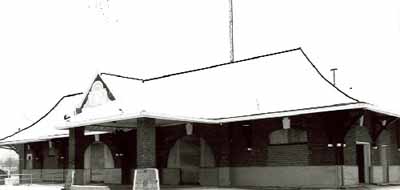Canadian National Railway Station
Heritage Railway Station of Canada
North Bay, Ontario

Front elevation
(© Agence Parcs Canada / Parks Canada Agency, A. M. de Fort-Menares, 1993.)
Address :
172 Second Avenue W., North Bay, Ontario
Recognition Statute:
Heritage Railway Stations Protection Act (R.S.C., 1985, c. 52 (4th Supp.))
Designation Date:
1994-01-07
Dates:
-
1916 to 1916
(Construction)
Event, Person, Organization:
-
Canadian Northern Railway
(Organization)
-
Canadian National Railways
(Organization)
-
George Carruthers Briggs
(Architect)
Other Name(s):
-
Canadian Northern Railway Station
(Other Name)
Research Report Number:
RS-171
Description of Historic Place
The former Canadian National Railway (CNR) station in North Bay, Ontario is a single storey brick station with a high hipped roof and Romesque Revival features. It constitutes a substantial presence at the head of Fraser St. where it stands on a 15-foot elevation with a porte-cochere that reaches towards the street.
Heritage Value
The CNR station at North Bay, Ontario, has been designated a heritage railway station for its environmental importance, and also for its historical and architectural significance.
It was built by the CNoR in 1916 as part of Canada’s third transcontinental railway line. Since North Bay was dependent upon rail transport to exploit local natural resources, the town became a busy railway centre. The CNoR arranged for the Temiskaming and Northern Ontario Railway (T&NO, later renamed Ontario Northland) to share facilities in 1921, and this became a union station. This role was enhanced after Canadian National Railways (CNR) acquired the station and persuaded three of the four railway companies active in North Bay to use its facilities.
In its large size and its well-executed yet retardataire historical detail, this station exemplifies early 20th century stations. It is built solidly of brick and stone, with details taken from the Romanesque Revival, and it is graced with a broad, welcoming porte-cochère. The building was designed by George Carruthers Briggs, then Supervisor of Buildings for the Eastern lines of the CNoR. The handling and finish of the interior spaces were generally more sophisticated than those found in most stations.
The heritage value of the CNR station at North Bay resides in its distinctive grand scale in the Romanesque Revival style, in its durable, high quality materials, and in its expansive well-illuminated interior spaces.
Source:
Heritage Character Statement, North Bay Canadian Northern Railway Station, October 1993. Heritage Assessment Report RSR-171,1993.
Character-Defining Elements
Character-defining elements of the North Bay Canadian National Railway Station include: its rectangular footprint with a projecting central south side porte-cochere, its 1 storey massing under a high hipped roof with bell-cast eaves, supplemented a similarly pitched roof with a triangular pediment over the porte-cochere, its balanced horizontal definition, its assymmetrical vertical proportions, the rhythmic placement of its apertures, the smooth aesthetic integration of special railway features such as a projecting telegrapher’s bay and broad eaves to provide passenger shelter, its restrained, Romanesque Revival details: arches over window and door arrangements, broad eaves, pedimented porte-cochere, use of keystones, corbels and canopy brackets, its rich original materials: brick walls, brick, cut-stone and wood details, wooden doors and trim, the high quality of craftsmanship evident in its masonry work, all original furnishings and fabric inside the station, the integrity of remnants of the station’s original sophisticated, disciplined functional plan, and in particular its general waiting room, baggage room, smoking room with attached gentlemen's toilet, ticket office and lobby, and a ladies' waiting room, legibility of the station’s original interior spatial volumes, the continuity of longstanding circulation patterns, in particular the pedestrian subway under the building and the elevator to the original express room, the overall integrity of the building’s form, plan, material, and detail.